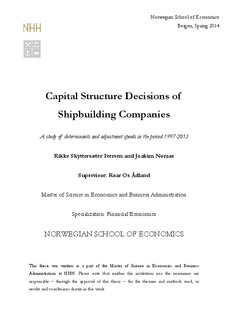Capital structure decisions of shipbuilding companies : a study of determinants and adjustment speeds in the period 1997-2013
Master thesis
Permanent lenke
http://hdl.handle.net/11250/220846Utgivelsesdato
2014Metadata
Vis full innførselSamlinger
- Master Thesis [4372]
Sammendrag
This thesis aims to investigate which factors are the major determinants of capital structure decisions for globally listed shipbuilding companies, and how quickly they adjust their capital structures when deviating from their target leverage ratios. Earlier academic articles have highlighted a number of firm specific factors that determine capital structures in other industries. This thesis gives special attention to the similarities between the merchant shipping industry researched by Drobetz et al. (2013) and the shipbuilding industry. We will use and apply determinants tested on the shipping industry to our sample of shipbuilders, but also add a set of new industry specific variables. To a large extent, unobserved company specific effects drive shipbuilders’ capital structure decisions. Using a range of multiple regression models we find size, asset risk, and the market to book ratio to be the most influential observable determinants of capital structure. Our results imply that shipbuilding companies do not follow one explicit capital structure theory, but a combination of the trade-off theory and the pecking order theory. The former theory dominates the firm level determinants, whereas the latter dominates with regards to the influence from the macroeconomic environment. Shipbuilders can be said to have relatively lower adjustment than deviation costs compared to other industries, as shipbuilders tend to adjust their capital structures significantly faster. The rate of adjustment is heavily dependent on macroeconomic cycles because the shipbuilders actively change their leverage ratios much slower in times of recession. This indicates that the adjustment costs increase during worsened economic conditions.
